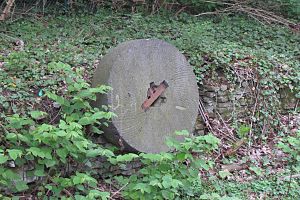Plinzenmühle
| Plinzenmühle
|
||
|---|---|---|
|
Millstone at the site of the former Plinzenmühle |
||
| Location and history | ||
|
|
||
| Coordinates | 51 ° 14 '23 " N , 6 ° 23' 39" E | |
| Location | Germany | |
| Waters | Hammer Bach | |
| Built | First mentioned in 1246 | |
| Shut down | 1920, demolished after 1945 | |
| technology | ||
| use | Grain mill | |
| Grinder | 1 grind | |
| drive | Watermill | |
| water wheel | medium-sized | |
The Plinzenmühle in the town of Viersen was a water mill with a medium-sized water wheel .
Mills in Viersen
In the past centuries there were a total of 18 mills in the municipality of Viersen. Four of these Rosso Oil Mills were hammer mills . These were operated by horse power. There were also two windmills , the Hoser and Hüsterfeld windmills , both of which were privately owned.
It was different with the watermills. The pen St. Gereon in Cologne had the basic rule of Viersen and the water rights on the streams in Viersen. The construction of watermills required his approval. The monastery granted mill rights as a hereditary fiefdom and received an annual tenancy from them. This had to be delivered to the parish office of St. Remigius. These documents show that there were twelve water mills in Viersen as early as 1246. All mills, with the exception of the monastery mill , paid a sum (about one hundredweight) of malt annually as loan interest. In the glory of Viersen there was no pressure to mill . All farmers could have milled wherever they wanted.
These twelve mills were on:
- " Dorfer Bach ": Kaisermühle , Kimmelmühle , Goetersmühle , Biestenmühle and Schricksmühle
- " Hammer Bach ": Plinzenmühle, Schnockesmühle , Sgoedenmühle , Bongartzmühle , Hüstermühle and Hammer Mühle
- " Rintger Bach ": Klostermühle
geography
The Plinzenmühle was located on Hammer Bach on Weiherstrasse in the Oberbeberich district , in the town of Viersen in the Viersen district. There was a pond in front of the mill . The water level of the Hammer Bach in this area was 52 m above sea level. The mill was on the narrow path that leads from Bebericher Strasse across from Berliner Höhe to Weiherstrasse. Below the Plinzenmühle was the Schnockesmühle.
The Hammer Bach supplied six mills with water for centuries. The care and maintenance of the water is the responsibility of the water and soil association of the Middle Niers, which is based in Grefrath .
history
The topmost of the mills on Hammer Bach was the Plinzenmühle. At the beginning of the 18th century it belonged to a miller family Nensch and was therefore also called Nenschmühle. In addition to this personal name, she also had the older name "Plinzenmühle". This meant the fact that buckwheat flour was made here. "Plinsen" is the buckwheat pancake. "Thoenes (Anton) up der plinsen Moellen" was the name of the first known miller on this mill (1408). Because of its hillside location, the Plinzenmühle had a medium-sized water wheel that drove a grinding process. In 1809 the daily grindability of the mill was one and a half Malter grain. (One painter = three hundredweight) The mill stopped grinding around 1920. The building was closed after 1945 and the pond was filled in.
gallery
Retention basin below the Plinzenmühle
literature
- Hans Vogt: Lower Rhine water mill guide. Krefeld 1998, pp. 511-523.
- Ferdinand Dohr: About the water being in the old Viersen. In: Heimatbuch des Kreis Kempen-Krefeld. 25th episode / 1974, pp. 47-55.




